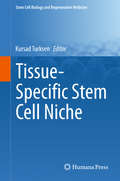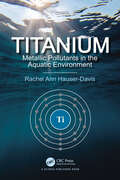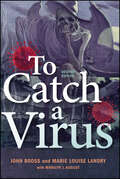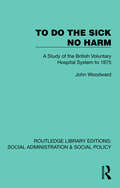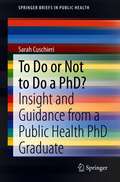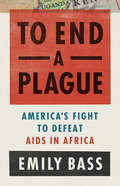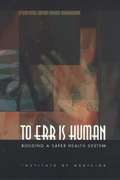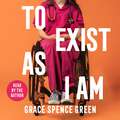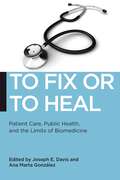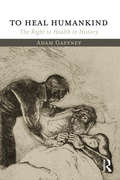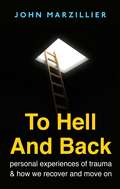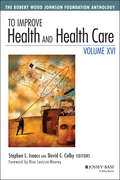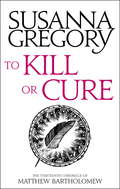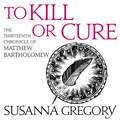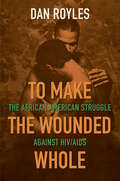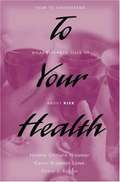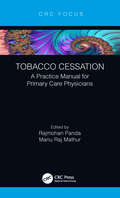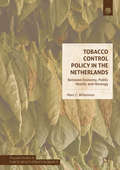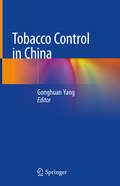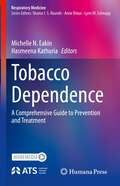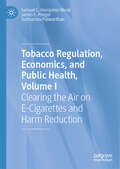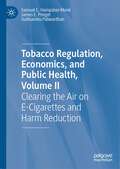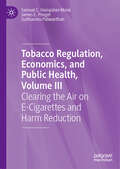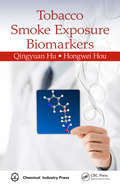- Table View
- List View
Tissue-Specific Estrogen Action
by Tim Wintermantel Kenneth S. KorachCurrent molecular understanding of estrogen action has greatly profited from advances in molecular cell biology. These advances, and their implications for clinical use, were discussed by leading researchers from industry and academia during an international symposium held in Berlin, 1-3 March 2006 and are featured in this volume.
Tissue-Specific Stem Cell Niche
by Kursad TurksenThis timely volume explores tissue-derived stem cells, summarizing and evaluating the current body of knowledge. Sixteen chapters cover hematopoietic, osteoblast, skeletal, cardiac, pancreatic, epithelial, corneal, hepatic, renal, testicular, ovarian, fingernail, hair follicle and other stem cells- discussing their individual development, functions and pathologies, as well as the commonalities and interdependence between niches. This installment of the popular Stem Cell Biology and Regenerative Medicine series delivers authoritative, international perspectives on this rapidly growing field. Tissue-Specific Stem Cell Niche is an ideal complementary volume to Biology of Stem Cell Niche and Adult Stem Cells, Second Edition and will be invaluable to clinicians and researchers working with stem cells as well as to postgraduate trainees who are studying them.
Titanium: Metallic Pollutants in the Aquatic Environment
by Rachel Ann Hauser-DavisThis book engages readers in an integrated and holistic discussion on titanium properties, applications, bioanalytical approaches and toxicity. Key issues include environmental titanium exposure and associated health risk concerns for both humans and aquatic organisms, exploring ecotoxicological effects. The book delves into the intricate web of ecotoxicological effects, offering valuable insights for researchers and professionals alike. With a broad appeal, this book is an indispensable resource for those immersed in the realms of oceanography, geochemistry, ecotoxicology, and environmental and public health, providing a multidisciplinary perspective on the intricate interplay between titanium and the natural world.
To Catch A Virus (ASM Books)
by Marie Louise Landry John BoossTo Catch a VirusTrace the evolution of diagnostic virology from yellow fever to COVID-19 Join expert storytellers John Booss, Marilyn J. August, and Marie Louise Landry in a journey through the history of viral epidemics and the detective work of those determined to identify the culprits and treat the infected. From the identification of the first virus in the late 1800s to the molecular techniques that enabled the rapid recognition of and vaccine development for the SARS-CoV-2 virus, viral diagnostic methods have progressed over the past century to become a formidable tool in human health care. This collection of gripping historical narratives covers a range of fascinating outbreaks and public health challenges, from yellow fever and smallpox to AIDS and COVID-19. This new edition chronicles the ongoing story of the COVID-19 pandemic, highlighting the people, the pathogen, and the progress in the diagnostic laboratory and clinical settings that has touched every aspect of global health. The many photographs and rich biographical sketches of key figures, diagrams of diagnostic procedures, micrographs of virus-infected cells, timelines, and a new glossary of key terms make To Catch a Virus compelling reading. This book serves as an excellent resource for courses in virology, immunology, microbiology, and public health. As the world struggles with the ongoing pandemic of SARS-CoV-2/COVID-19, To Catch a Virus is an insightful and superbly told story that chronicles the incredible metamorphosis of diagnostic virology and the technological advances that now make it possible to quickly and accurately detect and monitor the many disease-causing viruses that plague humankind. A stimulating, informative, and absorbing read that is highly recommended.—Richard L. Hodinka, PhD, Professor Emeritus, Perelman School of Medicine at the University of Pennsylvania; former Director, Clinical Virology Laboratory, Children&’s Hospital of Philadelphia To Catch a Virus provides a beautifully written and compelling story of scientific discovery. It carefully traces the understanding of viral diseases from the turn of the twentieth century to the present. For general readers the authors provide timely and expert guidance to the extraordinary advances in diagnosis, surveillance, and therapeutics that constitute the silver lining in the otherwise somber years of COVID-19. For anyone wishing to understand the challenges confronting virologists and their accomplishments to date, this work is the place to start.—Frank M. Snowden, PhD, Andrew Downey Orrick Professor Emeritus of History, Yale University; former Chair, Program in History of Science and History of Medicine, Yale University
To Do The Sick No Harm: A Study of the British Voluntary Hospital System to 1875 (Routledge Library Editions: Social Administration & Social Policy)
by John WoodwardWhat part did the British voluntary hospital system play in the health of the community in the eighteenth and nineteenth centuries? Did hospitals kill or cure? Originally published in 1974, this study investigates these questions through a pioneering examination of the extant hospital records, ranging from admissions registers to annual reports, and by an analysis of the contemporary literature. It relates the hospital system to the changing economic and social environment and is primarily concerned with the patients themselves and their experiences. The lack of medical treatment for the bulk of the population is emphasised, and the influence of the reformers on the foundation of the first voluntary hospitals in the beginning of the 18th century is assessed. Staffing and administrative procedures are studied as a prelude to examining the patients – their social background and physical and surgical complaints. Important aspects of the hospitals’ work and their influence on the rate of mortality are explored. They are admissions policy regarding fever cases; the nature and number of surgical cases and the incidence of sepsis. The effect of growing urbanization and industrialization on the success of the voluntary hospitals in the 19th century is also examined.
To Do or Not to Do a PhD?: Insight and Guidance from a Public Health PhD Graduate (SpringerBriefs in Public Health)
by Sarah CuschieriThis book prepares and guides individuals who are about to embark (or already have embarked) on a health/medical PhD journey, with a specific focus on Public Health. Based on the author's experience as a recently graduated Doctor of Philosophy (PhD) student, readers benefit from the knowledge imparted and lessons learned, including an analysis of the different aspects of a Public Health doctoral degree, and practical tips and guidance on how to go about this journey from the initial phase of choosing a research niche up until the oral examination (also called defence). All throughout the book, the author shares examples from her own journey to show that in spite of sacrifices and hurdles along the way, hard work, perseverance, and supportive resources can help see you through, eventually, to a hopefully positive outcome at the end.Using an informal style, the author provides a step-wise guide, from chapter to chapter, on the various essential aspects that need to be considered, including:The initial steps towards a PhDProposal, permissions and fundingThe fieldworkThe art of data analysisThe hurdles along the way – a personal experienceWhat comes after the completion of a PhD?Intended to be a compact go-to guide for students throughout their PhD journey, both from an academic and personal perspective, To Do or Not to Do a PhD? engages readers who are about to enroll in or who already have started a PhD, especially in public health, epidemiology, and health/medical fields of study. The brief also would appeal to postgraduate and undergraduate students who are interested in learning about how to write a research proposal, draft a scientific paper for publication in a journal, or prepare a thesis.
To End a Plague: America's Fight to Defeat AIDS in Africa
by Emily Bass&“Randy Shilts and Laurie Garrett told the story of the HIV/AIDS epidemic through the late 1980s and the early 1990s, respectively. Now journalist-historian-activist Emily Bass tells the story of US engagement in HIV/AIDS control in sub-Saharan Africa. There is far to go on the path, but Bass tells us how far we&’ve come.&” —Sten H. Vermund, professor and dean, Yale School of Public Health With his 2003 announcement of a program known as PEPFAR, George W. Bush launched an astonishingly successful American war against a global pandemic. PEPFAR played a key role in slashing HIV cases and AIDS deaths in sub-Saharan Africa, leading to the brink of epidemic control. Resilient in the face of flatlined funding and political headwinds, PEPFAR is America&’s singular example of how to fight long-term plague—and win. To End a Plague is not merely the definitive history of this extraordinary program; it traces the lives of the activists who first impelled President Bush to take action, and later sought to prevent AIDS deaths at the whims of American politics. Moving from raucous street protests to the marbled halls of Washington and the clinics and homes where Ugandan people living with HIV fight to survive, it reveals an America that was once capable of real and meaningful change—and illuminates imperatives for future pandemic wars. Exhaustively researched and vividly written, this is the true story of an American moonshot.
To Err is Human: Building a Safer Health System
by Linda T. Kohn Janet M. Corrigan Molla S. DonaldsonExperts estimate that as many as 98,000 people die in any given year from medical errors that occur in hospitals. That's more than die from motor vehicle accidents, breast cancer, or AIDS--three causes that receive far more public attention. Indeed, more people die annually from medication errors than from workplace injuries. Add the financial cost to the human tragedy, and medical error easily rises to the top ranks of urgent, widespread public problems. To Err Is Human breaks the silence that has surrounded medical errors and their consequence--but not by pointing fingers at caring health care professionals who make honest mistakes. After all, to err is human. Instead, this book sets forth a national agenda--with state and local implications--for reducing medical errors and improving patient safety through the design of a safer health system. This volume reveals the often startling statistics of medical error and the disparity between the incidence of error and public perception of it, given many patients' expectations that the medical profession always performs perfectly. A careful examination is made of how the surrounding forces of legislation, regulation, and market activity influence the quality of care provided by health care organizations and then looks at their handling of medical mistakes. Using a detailed case study, the book reviews the current understanding of why these mistakes happen. A key theme is that legitimate liability concerns discourage reporting of errors--which begs the question, "How can we learn from our mistakes?" Balancing regulatory versus market-based initiatives and public versus private efforts, the Institute of Medicine presents wide-ranging recommendations for improving patient safety, in the areas of leadership, improved data collection and analysis, and development of effective systems at the level of direct patient care. To Err Is Human asserts that the problem is not bad people in health care--it is that good people are working in bad systems that need to be made safer. Comprehensive and straightforward, this book offers a clear prescription for raising the level of patient safety in American health care. It also explains how patients themselves can influence the quality of care that they receive once they check into the hospital. This book will be vitally important to federal, state, and local health policy makers and regulators, health professional licensing officials, hospital administrators, medical educators and students, health caregivers, health journalists, patient advocates--as well as patients themselves. First in a series of publications from the Quality of Health Care in America, a project initiated by the Institute of Medicine.
To Exist As I Am: A Doctor's Notes on Recovery and Radical Acceptance
by Grace Spence GreenREAD BY THE AUTHOR.'Astonishing, important, and truly radical ... this book is completely transformative' POLLY MORLAND 'To Exist As I Am reflects on the boundaries between those who care, and those who receive care in an absolutely extraordinary way ... Essential reading' XAND VAN TULLEKEN 'Inspiring and life-affirming' VIV GROSKOP It wasn't a car crash, but there was a collision. He fell from the third floor. At the age of twenty-two, Grace Spence Green's spine was broken at the fourth thoracic vertebra, and her life changed tracks. One day, she was in hospital supporting patients, the next she was one. To Exist As I Am traces Grace's journey back to the wards and back to herself - as words like recovery, independence and community, well and unwell, took on new meanings. She asks how we might fight for change, while joyously embracing life exactly as we are. 'It'll change the way you think about disability. Stop whatever it is that you're reading and read Grace Spence Green instead' GAVIN FRANCIS 'Unputdownable, awe-inspiring, necessary' GABRIEL WESTON 'So true and so beautiful' TOM SHAKESPEARE'
To Fix or To Heal: Patient Care, Public Health, and the Limits of Biomedicine (Biopolitics #3)
by Joseph E. Davis Ana Marta GonzálezDo doctors fix patients? Or do they heal them? For all of modern medicine’s many successes, discontent with the quality of patient care has combined with a host of new developments, from aging populations to the resurgence of infectious diseases, which challenge medicine’s overreliance on narrowly mechanistic and technical methods of explanation and intervention, or “fixing’ patients. The need for a better balance, for more humane “healing” rationales and practices that attend to the social and environmental aspects of health and illness and the experiencing person, is more urgent than ever. Yet, in public health and bioethics, the fields best positioned to offer countervailing values and orientations, the dominant approaches largely extend and reinforce the reductionism and individualism of biomedicine.The collected essays in To Fix or To Heal do more than document the persistence of reductionist approaches and the attendant extension of medicalization to more and more aspects of our lives. The contributors also shed valuable light on why reductionism has persisted and why more holistic models, incorporating social and environmental factors, have gained so little traction. The contributors examine the moral appeal of reductionism, the larger rationalist dream of technological mastery, the growing valuation of health, and the enshrining of individual responsibility as the seemingly non-coercive means of intervention and control. This paradigm-challenging volume advances new lines of criticism of our dominant medical regime, even while proposing ways of bringing medical practice, bioethics, and public health more closely into line with their original goals. Precisely because of the centrality of the biomedical approach to our society, the contributors argue, challenging the reductionist model and its ever-widening effects is perhaps the best way to press for a much-needed renewal of our ethical and political discourse.
To Heal Humankind: The Right to Health in History
by Adam GaffneyThe "human right to healthcare" has had a remarkable rise. It is found in numerous international treaties and national constitutions, it is litigated in courtrooms across the globe, it is increasingly the subject of study by scholars across a range of disciplines, and—perhaps most importantly—it serves as an inspiring rallying cry for health justice activists throughout the world. However, though increasingly accepted as a principle, the historical roots of this right remain largely unexplored. To Heal Humankind: The Right to Health in History fills that gap, combining a sweeping historical scope and interdisciplinary synthesis. Beginning with the Age of Antiquity and extending to the Age of Trump, it analyzes how healthcare has been conceived and provided as both a right and a commodity over time and space, examining the key historical and political junctures when the right to healthcare was widened or diminished in nations around the globe. To Heal Humankind will prove indispensable for all those interested in human rights, the history of public health, and the future of healthcare.
To Hell and Back: Personal Experiences of Trauma and How We Recover and Move on
by John MarzillierDespite how rare one-off traumatic events may seem, the statistics show that the majority of us are likely to experience such trauma at some point in our lives. In this innovative and engaging book, Marzillier combines first-hand accounts from trauma sufferers with over forty years of clinical practice to provide an honest, human description of how trauma affects us at the time and also after the event. Whether discussing accounts of terrorist bombings, natural disasters, road accidents or physical attacks, he looks at what these experiences do to us and offers practical and consoling advice - for both sufferers and their loved ones - on coping with the experience and developing resilience for the future.
To Improve Health and Health Care, Volume XVI
by Stephen L. Isaacs David C. Colby Risa Lavizzo-MoureyThe RWJF's biannual update on the latest developments in U.S. health care To Improve Health and Health Care is the Robert Wood Johnson Foundation's biannual anthology, focusing on the pressing health and health care issues facing the country. <P><P>This volume covers some of the most important topics in public health, preventative medicine, and health services. Readers will find an in-depth look into the programs funded by the Robert Wood Johnson Foundation, providing policy makers, practitioners, and interested members of the public a valuable perspective to inform strategy for the coming years. As part of the Foundation's efforts to inform the public, this ongoing anthology of the RWJF provides an update on the latest developments and advances taking place in the field of health, bringing readers up to speed on where we are, and where we still need to go. Understand the new developments in reducing childhood obesity Examine innovations in health care delivery Learn how RWJF programs are making a difference to patients and providers Since 1972, the Robert Wood Johnson Foundation has been the nation's largest philanthropy devoted exclusively to health. To further its mission of improving the health and health care of all Americans, the Foundation strives to foster innovation, develop ideas, disseminate information, and enable committed people to devote their energies to improving the nation's well-being. To Improve Health and Health Care describes the latest outcomes and progress, for a complete overview of the American health care system.
To Kill Or Cure: The Thirteenth Chronicle of Matthew Bartholomew (Chronicles of Matthew Bartholomew #13)
by Susanna GregoryFor the twentieth anniversary of the start of the Matthew Bartholomew series, Sphere is delighted to reissue all of the medieval monk's cases with beautiful new series-style covers.------------------------------------The winter of 1353 has been appallingly wet, there is a fever outbreak amongst the poorer townspeople and the country is not yet fully recovered from the aftermath of the plague. The increasing reputation and wealth of the Cambridge colleges are causing dangerous tensions between the town, Church and University. Matthew Bartholomew is called to look into the deaths of three members of the University of who died from drinking poisoned wine, and soon he stumbles upon criminal activities that implicate his relatives, friends and colleagues - so he must solve the case before matters in the town get out of hand...In the year 1357, Cambridge University is in dire financial straits: the town's landlords are demanding an extortionate rent rise for the students' hostels and the plague years have left the colleges with scant resources. Tension between town and gown is at boiling point and soon explodes into violence and death. Into this maelstrom comes a charismatic physician whose healing methods owe more to magic than medicine - but his success threatens Matthew Bartholomew's professional reputation, and his life ...
To Kill Or Cure: The Thirteenth Chronicle of Matthew Bartholomew (Chronicles of Matthew Bartholomew #13)
by Susanna GregoryCambridge University is in dire financial straits: the town's landlords are demanding an extortionate rent rise for the students' hostels and the plague years have left the colleges with scant resources. Tension between town and gown is at boiling point and soon explodes into violence and death. Into this maelstrom comes a charismatic physician whose healing methods owe more to magic than medicine but his success threatens Matthew Bartholomew's professional reputation, and his life ...
To Make the Wounded Whole: The African American Struggle against HIV/AIDS (Justice, Power, and Politics)
by Dan RoylesIn the decades since it was identified in 1981, HIV/AIDS has devastated African American communities. Members of those communities mobilized to fight the epidemic and its consequences from the beginning of the AIDS activist movement. They struggled not only to overcome the stigma and denial surrounding a "white gay disease" in Black America, but also to bring resources to struggling communities that were often dismissed as too "hard to reach." To Make the Wounded Whole offers the first history of African American AIDS activism in all of its depth and breadth. Dan Royles introduces a diverse constellation of activists, including medical professionals, Black gay intellectuals, church pastors, Nation of Islam leaders, recovering drug users, and Black feminists who pursued a wide array of grassroots approaches to slow the epidemic's spread and address its impacts. Through interlinked stories from Philadelphia and Atlanta to South Africa and back again, Royles documents the diverse, creative, and global work of African American activists in the decades-long battle against HIV/AIDS.
To Your Health: How to Understand What Research Tells Us About Risk
by David J. Kupfer Helena Chmura Kraemer Karen Kraemer LoweThis is a guide to the critical reading of risk research reports directed to informed consumers, physicians, as well as to scientists evaluating the risk research literature or contemplating risk research projects.
Tobacco Cessation: A Practice Manual for Primary Care Physicians
by Rajmohan Panda Manu Raj MathurCessation of tobacco use is the need of the hour given that it is the single largest cause of disease and premature death in the world. This book covers epidemiology and risks, user classification, nicotine replacement therapy, pharmacological aids, behavioral modification and patient counseling techniques, along with personalized action plan development. Key Features Covers all aspect of tobacco cessation. Provides guidance on differential diagnosis and includes useful decision-making flowcharts. Provides step-by-step guidance to counsel tobacco users in routine clinical practice. Discusses the process of setting up a cessation centre. Facilitates in-depth understanding of the subject through case studies at the end of each chapter
Tobacco Control Policy in the Netherlands: Between Economy, Public Health, and Ideology (Palgrave Studies in Public Health Policy Research)
by Marc C. WillemsenGovernments have known since the 1960s that smoking results in irreversible health damage. This open access book examines why governments have done so little to combat this when they have been aware of the problem and its solutions for decades. What are the strategies and decisions that make a difference, given that policy environments are often not conducive to change? Taking the Netherlands as an example, this book helps to understand the complex policy process at the national level and why it so often appears irrational to us. It is the most sophisticated analysis of tobacco control policy to date, applying insights from political sciences to the field of tobacco control.
Tobacco Control in China
by Gonghuan YangThis book comprehensively covers the science and policy issues relevant to one of the major public health issues in China. It pulls together the prevalence pattern of tobacco use in different population and burden of the myriad of tobacco-related diseases. The book pays more attention to review the successes and failures of tobacco control policies in China, including the protect peoples from second-hand smoke, comprehensive banning tobacco advertisement promotion and sponsor, regulation of the contents of tobacco products and low tar cigarettes, warn about the dangers of tobacco, support for smokers to quit, and increasing tobacco taxation and price, as well as monitor and assessment on tobacco use and implement of prevention policy under the international background of tobacco control.The book analyse and explain the influence factors, especially interference from tobacco industry with public management theory frame for promoting tobacco control policies and looks at lessons learnt to help set health policy for reducing the burden of tobacco-related diseases. It is a helpful reference for experts in public health and epidemiologists in tobacco control, advocators and policy maker.
Tobacco Dependence: A Comprehensive Guide to Prevention and Treatment (Respiratory Medicine)
by Michelle N. Eakin Hasmeena KathuriaThis book is a guide to pharmacotherapy treatment of tobacco dependence. The 2020 American Thoracic Society clinical practice guidelines on treating tobacco dependence serves as the cornerstone for this work with its robust discussion of recommended treatment options and how to tailor treatment to specific patient populations. Tobacco dependence remains a major health concern for many adults and given the dramatic increase of youth electronic cigarette use, clinicians need a singular resource to treat these different populations. This book addresses that by following the three main points of how to best address the adverse impact of tobacco use on public health: 1) prevent initiation of tobacco use; 2) understand mechanisms of addiction; 3) effectively treat tobacco dependence.The book begins by describing the current patterns of product use, the adverse impact of tobacco on global health, and tobacco-related health disparities. Authors discuss both combustible and electronic tobacco products, as well as current research on the adverse impact of vaping and associated flavorings including menthol, role of the e-cigarette in cessation, and treatment of adolescent nicotine dependence. Chapters conclude with a discussion of specific tobacco control policies to improve overall public health. This is an ideal guide for pulmonologists, pediatricians, primary care physicians and other specialty providers who see patients with nicotine dependence. This book is also of interest to public health professions to help inform public health campaigns and treatment offerings to reduce overall tobacco product use through prevention and treatment.
Tobacco Regulation, Economics, and Public Health, Volume I: Clearing the Air on E-Cigarettes and Harm Reduction
by Samuel C. Hampsher-Monk James E. Prieger Sudhanshu PatwardhanThe first volume of this three-volume resource presents a historical analysis of the practice of smoking, the rise and fall of the cigarette market, and the successes and failures of tobacco control. While taxes, regulations, and various behavioral and pharmacological interventions have helped many people to quit smoking, they have not helped everyone. The authors explain why these strategies alone are likely insufficient to elicit smoking cessation among the remaining group, and why “ramping up” these strategies may also backfire. Drawing on examples from the U.S., Australia, Canada, and the United Kingdom, this volume introduces the technology of e-cigarettes, explaining the origins of the innovation, patterns of use among consumers, and the perception of e-cigarettes among key stakeholder groups.
Tobacco Regulation, Economics, and Public Health, Volume II: Clearing the Air on E-Cigarettes and Harm Reduction
by Samuel C. Hampsher-Monk James E. Prieger Sudhanshu PatwardhanFor millions, e-cigarettes provide a means to relieve nicotine cravings while avoiding harmful cigarette smoke. In the second volume in this three-volume resource, the authors provide a critical review of evidence concerning the health effects of vaping and whether using e-cigarettes helps or hinders cessation from smoking. The empirical evidence, however, does not help decision-makers resolve the normative questions relating to e-cigarettes. Different priorities, values, and interpretations of available data have led to seemingly intractable disagreements between stakeholders about the promise of e-cigarettes for smoking cessation and the risks they pose to public health. The misinformation and motivated bias surrounding issues regarding vaping both follow from but also enhance polarization, perpetuating confusion about e-cigarettes and leading to poor decision-making by government agencies and people who smoke. The authors argue that, ultimately, the safety and efficacy of e-cigarettes for smoking cessation are not immutable properties of the product class–itself diverse and dynamic–but are also contingent upon the conditions of the regulatory environment, and the manner in which e-cigarettes are discussed by regulators and the media. This volume provides important context to help decision makers at all levels better understand the risk and benefits of e-cigarettes and the tradeoffs between them.
Tobacco Regulation, Economics, and Public Health, Volume III: Clearing the Air on E-Cigarettes and Harm Reduction
by Samuel C. Hampsher-Monk James E. Prieger Sudhanshu PatwardhanWhat role should the tobacco industry have in the e-cigarette market? Should manufacturers contribute to the production of evidence on their products’ safety and efficacy? What are the environmental impacts of e-cigarette use and how should these feature in the discussion? How do e-cigarettes influence smoking-related health disparities? Should physicians recommend switching to e-cigarettes for those who smoke? How broadly applicable is the utility of e-cigarettes? And how should the discourse respond to emerging data? This volume examines the opportunities and challenges of optimizing e-cigarette regulation. The authors describe emerging evidence suggesting that restrictions on e-cigarettes can backfire by nudging consumers toward riskier alternatives. Adopting a social welfare-based approach drawing on economics, policy analysis and regulatory science, the authors then explore how optimal e-cigarette policy might balance risks and benefits, suggesting that it is possibleto leverage the promise of e-cigarettes—a product that is more popular than traditional cessation aids—to protect current and future generations from the smoking-related harms, while still taking important steps to discourage use by young people and those who do not smoke.
Tobacco Smoke Exposure Biomarkers
by Qingyuan Hu Hongwei HouWritten by experts in the analytical chemistry of tobacco smoke, Tobacco Smoke Exposure Biomarkers summarizes the toxicology, metabolic pathway, and biomarkers of nicotine, TSNAs, PAHs, VOCs, AAs, Catechol and Hydroquinone, HCN, CO and NOx, and heavy metals, and the use of this biomarker in exposure assessment and/or cigarette smoke exposure enviro

